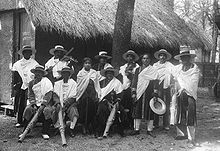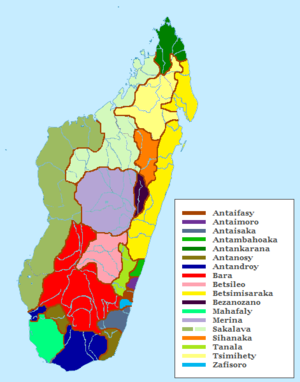Malagasy peoples
This article needs additional citations for verification. (September 2014) |
  Top: A Malagasy street vendor; Bottom: A traditional Malagasy Valiha orchestra | |
| Total population | |
|---|---|
| c. 26.8 million | |
| Regions with significant populations | |
| Madagascar, Comoros, Mayotte, Réunion, Mauritius, France, United Kingdom, United States, South Africa, Australia, Canada, New Zealand | |
| Languages | |
| Malagasy (L1) French (L2) | |
| Religion | |
| Christianity, Traditional Faiths, Islam | |
| Related ethnic groups | |

The Malagasy (
The Merina are further divided into two subgroups. The “Merina A” are the Hova and Andriana, and have an average of 30–40% Bantu ancestry. The second subgroup is the “Merina B”, the Andevo, who have an average of 40–50% Bantu ancestry. The latter make up less than 1/3 of Merina society.[1] The Malagasy population was 2,242,000 in the first census in 1900. Their population had a massive growth in the next hundred years, especially under French Madagascar.
Genetics and origins of the populations
An expansive island-wide survey of the genetic diversity was performed from 2008 to 2018. This project was called "MAGE" (for Madagascar, Anthropology Genetics Ethno-linguistic[2]). Around 3000 inhabitants of Madagascar participated in this study and provided their saliva for a genetic study. Three hundred villages across Madagascar were sampled in terms of genetic, linguistic and cultural diversity. This research was led and performed by Malagasy and European researchers and academics. This study demonstrated that all Malagasy people have mixed African and Asian ancestry.[3]
But the proportion of ancestral genes differs. Coastal Malagasy populations, including the
Due to the proximity to Africa, the connection with Asian populations aroused the most curiosity. Around 1996, a study was launched in an attempt to identify the presence of the
Based on this result, a study suggested that Madagascar was settled approximately 2,200 years ago by a very small group, which consisted of approximately 30 women; 28 (93%) of them had maritime Southeast Asian descent and 2 (7%) of them were of African descent. The Malagasy population developed through the intermixing of the first small founding population with African males. The closest Asian parental population of the Malagasy are found in what is now Indonesia, among the
Historical subdivisions
The difference in origins remains somewhat evident between the highland and coastal regions [
Within these two broad ethnic and political groupings, the Malagasy were historically subdivided into specifically named ethnic groups, who were primarily distinguished from one another on the basis of cultural practices. These were namely agricultural, hunting, or fishing practices; construction style of dwellings; music; hair and clothing styles; and local customs or taboos, the latter was known in the Malagasy language as fady.[citation needed] The number of such ethnic groups in Madagascar has been debated. The practices that distinguished many of these groups are less prevalent in the 21st century than they were in the past. But, many Malagasy are proud to proclaim their association with one or several of these groups as part of their own cultural identity.
- "Highlander" ethnic groups
- Coastal ethnic groups
- Antaifasy or Antefasy
- Antaimoroor Temoro or Antemoro
- Antaisaka or Antesaka
- Antambahoaka
- Antandroy or Tandroy
- Antankarana
- Antanosy or Tanosy
- Bara
- Betsimisaraka
- Bezanozano
- Mahafaly
- Makoa
- Mikea
- Sakalava
- Tanala
- Tsimihety
- Vezo
Malagasy diaspora
Countries with a significant Malagasy diaspora include
.The Malagasy diaspora in the United States includes those descended from people who, slave or free, came during the 18th and 19th centuries.
The first recorded African slave in Canada, Olivier Le Jeune, was taken from Madagascar to New France in 1628.
See also
- Malagasy language
- Culture of Madagascar
- Culture of Indonesia
- Oceanian culture
- Seychellois Creole people
- Mauritian Creoles
- Cafres
- Cape Malay
References
- ^ "Genomic investigation of the ancestry proportion of six Malagasy ethnic groups". Researchgate.
- ^ "Madagascar, illustration inédite de la mondialisation génétique | INEE". inee.cnrs.fr (in French). Retrieved 2021-02-25.
- ^ PMID 28716916.
- PMID 24395773.
- S2CID 22042499.
- PMID 28716916.
- PMID 33481023.
- PMID 22438500.
- PMID 27188237.
- PMID 27381999.
- ^ Malagasy expatriates in France
- ^ Wendy Wilson-Fall on Malagasy Americans, Afropop.org, Accessed January 18, 2020
- ^ John, Egerton (September 1, 1991). Shades of Gray: Dispatches from the Modern South. p. 134.
- ^ NASA Johnson Space Center Oral History Project, April 29, 2004. Accessed May 15, 2020.
- ^ An American Family: The Mahammett Family of Maryland, Muslimsinamerica.org, Accessed January 18, 2020
- ^ “Finding Your Roots”: Maya Rudolph, Shonda Rhimes and Keenan Ivory Wayans, Familytreemagazine.com, Accessed May 15, 2020
- ^ Henry Louis Gates Jr., Finding Your Roots, Season 2: The Official Companion to the PBS Series, University of North Carolina Press, 2016, pg. 163
- ^ “Finding Your Roots”: Maya Rudolph, Shonda Rhimes and Keenan Ivory Wayans, Familytreemagazine.com, Accessed February 10, 2020
Further reading
- Memories of Madagascar and Slavery in the Black Atlantic by Wendy Wilson-Fall, 2015, Ohio University Press—Malagasy diaspora
- Sandra Evers, Gwyn Campbell, Michael Lambek (2013). Contest for Land in Madagascar: Environment, Ancestors and Development. African Social Studies Series. Brill. ISBN 9789004256231.
